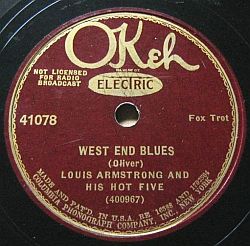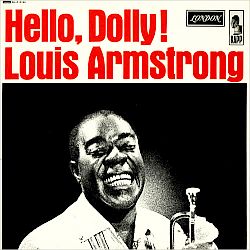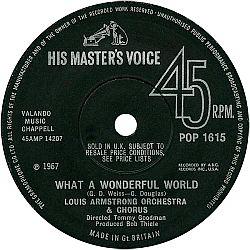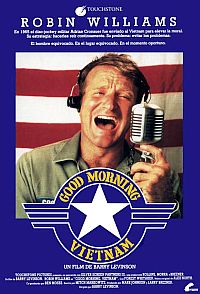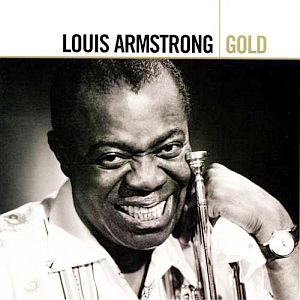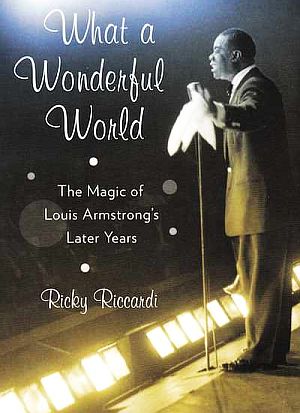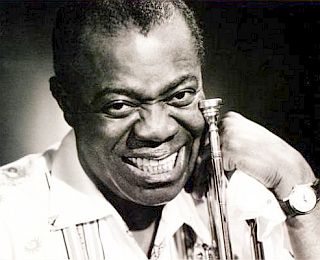
Louis Armstrong photo from cover of “Louis Armstrong Gold” CD, issued September 2006.
Music Player
“What A Wonderful World”
Louis Armstrong
However, this song, sampled above, had something of an uncertain beginning, as an ABC Records executive was opposed to its release. More on that later. First, some background and context.
By the mid-1960s Louis Armstrong was already a music legend, having been one of the paramount names of American jazz since the 1920s. Known for his trumpet playing, scat singing, and irrepressible smile, Armstrong by the 1960s had compiled a long list of hits, and also some movie credits. In his early years, Armstrong was best known for his virtuosity with the cornet and trumpet, with notable jazz renditions from his early years on his Hot Five and Hot Seven recordings.
A sample from that earlier era can be heard below in the second selection, a famous 1928 hit entitled “West End Blues” which also includes a bit of Armstrong scat vocals.Music Player
“West End Blues”-1928
“West End Blues” was written by King Oliver as a blues song, named for the West End of New Orleans, Louisiana, a popular picnic and entertainment area on Lake Pontchartrain. But it was Armstrong’s version of the song, made a few weeks after Oliver’s, that made it a landmark jazz recording.
In liner notes for the Ken Burns CD, The Definitive Louis Armstrong, jazz historian and music critic Doug Ramsey says of “West End Blues”:
“Mozart, Bartok, or Stravinsky would have been grateful for the inspiration to compose the nine-bar cadenza [Armstrong] improvised to open ‘West End Blues.’ In every element of conception and execution, the recording was a monumental achievement. It gave notice that jazz was capable of artistry at the highest level of human expression.”
In 1928, “West End Blues” also captured a feel for the times — laid back a bit, pre-Great Depression. The song was later inducted into the Grammy Hall of fame in 1974.
Armstrong was considered a jazz innovator who pushed the boundaries of the genre and his craft, later passing the baton to Lester Young, Charlie Parker and others. Among Armstrong’s hit recordings are: “Stardust”, “When The Saints Go Marching In,” “Dream a Little Dream of Me,” “Ain’t Misbehavin’,” “You Rascal You,” and “Stompin’ at the Savoy.” During his long career he played and sang with some of the most important instrumentalists and vocalists of the time; among them: Bing Crosby, Duke Ellington, Billie Holiday, Fletcher Henderson, Earl Hines, Jimmie Rodgers, Bessie Smith, and perhaps most famously, Ella Fitzgerald. Armstrong recorded three albums with Fitzgerald.
But by the mid-1960s, rock ’n roll and groups like the Beatles were all the rage. Old line jazz performers had become somewhat less visible. Yet Armstrong, in the midst of the rock `n roll tsunami, was having something of a renaissance.In December 1963, at the behest of his manager, Armstrong made a demo recording of “Hello, Dolly!” to promote the stage show which opened in New York in January 1964. Kapp Records released Armstrong’s demo as a commercial single and it became a surprise pop hit reaching No. 1 on the U.S. Billboard Hot 100. He was 63 when “Hello, Dolly!” topped the charts the week of May 9, 1964.
Armstrong’s “Hello, Dolly,” in fact, ended The Beatles’ streak of three No. 1 hits in a row over 14 consecutive weeks. It also spent nine weeks atop the adult contemporary chart. “Hello Dolly” became a giant hit for Armstrong, followed by a gold-selling album of the same name.
“Hello, Dolly!” also won the Song of the Year Grammy for 1965, and Armstrong received a Grammy for Best Vocal Performance. He would later perform the song in the popular 1969 film, Hello, Dolly!, which starred Barbra Streisand.

Louis Armstrong and Barbra Streisand in a scene from the film version of “Hello, Dolly!” Click for DVD.
The song was written by Bob Thiele and George David Weiss. Thiele was a record producer, and earlier as head of Impulse Records, he had issued recordings for jazz artists such as John Coltrane, Charles Mingus, Dizzy Gillespie, and others. Weiss was a songwriter who wrote or co-wrote many songs, including the hit version of “The Lion Sleeps Tonight.” Initially, Thiele and Weiss had pitched “What A Wonderful World” to Tony Bennett, who turned them down.
Then in the summer of 1967, another producer, Artie Butler, suggested the song might be offered to Louis Armstrong, who was then working on material for a prospective album. Armstrong agreed to do the song and in mid-August 1967, Thiele, Weiss and Butler traveled to Las Vegas where they would meet Armstrong for a late-night recording session.
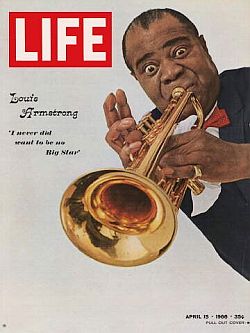
Louis Armstrong, on the cover of Life magazine in April 1966, where he is quoted saying, “I never did want to be no Big Star.” Click for copy.
Raucous Session
Armstrong was then appearing in performance at the Tropicana Hotel. After one of his midnight shows, a recording session was arranged at Bill Porter’s United Studios in Las Vegas. Armstrong, Theile, Weiss and Butler all met there along with a group of studio engineers and musicians. By the time they began recording it was around 2 a.m.
However, another person, ABC Records President Larry Newton, had also come to Las Vegas to meet with Armstrong, who had just signed with ABC Records. Newton had come to Las Vegas to have some publicity photos taken of his new star. Newton had high hopes for Armstrong’s music, as “Hello, Dolly!” had stormed the pop charts two years earlier, and Newton expected more of the same.
But Newton was not very excited about the slow-tempo ballad that was “What A Wonderful World.” Newton was opposed to Armstrong doing the song. In fact, he came to the late night recording session and tried to stop it – to the point where he had to be locked out of the studio while the session proceeded.
 Music arranger/composer Artie Butler shown at work with Louis Armstrong, Las Vegas, Aug 1967. |
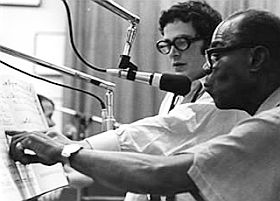 Artie Butler and Louis Armstrong at work in a late-night Las Vegas recording session that was reportedly made easier by Armstrong's good-natured levity. |
Recordings in those days were done “live” – with vocalist, band or orchestra, and any background vocals all recorded at the same time. A recording session could run through dozens of takes to get everything just right. Overdubbing was still rare then. That night in Las Vegas, however, proved to be very challenging as the session was interrupted twice by the sounds of a coming and going Union Pacific freight train near the studio, blowing its horn. And fuming ABC exec Larry Newton was still locked outside the studio, but making his presence known. The session could have gone bad at the point, given all the interruptions and tension with Newton. But according to one account, Armstrong himself lightened the load, by shaking his head at one point and laughing at the craziness involved, with others joining in. The work then proceeded with renewed determination.
Despite the interruptions, Armstrong and group eventually got the song they wanted, finishing their work around 6 a.m. Since the session had run longer than planned the musicians were due extra pay, and Armstrong only accepted the basic scale of $250 to make sure the orchestra members were paid.
Artie Butler, the arranger and composer who was also at the session, is shown in the two photos here at work with Armstrong that night. Butler, at the invitation of Theile, wrote the arrangement for “A Wonderful World.” Butler recalls that at the end of the late night session, “we were all starving so we went for breakfast,” during which they exchanged stories about their music and life experiences, and also shared a few jokes. Butler adds of that evening and the breakfast session:
…At the end of our breakfast, Louis grabbed me by my shoulders and pulled me over and kissed me on the head and said “Artie its been a real pleasure working with you and a gas laughing with you. Let’s do more.”
I will never ever forget the few hours I got to spend with Louis Armstrong. Every time I hear “What A Wonderful World” on the radio or TV it truly brings a warm feeling all over me as I reflect back to that special recording session and breakfast. These photos were taken at the recording session in Las Vegas … sometime between freight trains.
Song Held Back
Meanwhile, ABC’s Larry Newton – the guy who was locked out of the studio – would have his revenge apparently. The tapes for the recording of “What A Wonderful World” languished at ABC Records in New York for months, only being released in the U.K. in early 1968 to ABC Records’ partner there, EMI. “What A Wonderful World” came out there on one of EMI’s record labels named “His Masters Voice” (HMV), as shown in the photo at left.
The song first charted in the U.K. in February 1968 at No. 45, rising to No. 1 by April, staying there for four weeks. In fact, “What A Wonderful World” became the top-selling UK single in 1968. Back in the states, ABC’s Larry Newton refused to promote the song, and it reportedly sold only 1,000 copies.
But 1968 in the U.S. was turning out to be a very tumultuous year, with racial and political havoc added to the Vietnam War. It was also a presidential election year. Martin Luther King, Jr. and Robert Kennedy were both assassinated that spring and summer, and there was growing civil and racial unrest with urban riots and Viet Nam War protests.Some thought Armstrong’s song could be a positive antidote for the troubled world of 1968. In the midst of all this, songwriters Thiele and Weiss saw Armstrong as “the perfect ambassador to restore race relations” during America’s tumultuous summer. Yet since the 1950s, Armstrong had been charged by some as being an “Uncle Tom,” catering to white America with his music. But Armstrong’s appeal at the time extended to all races, and the hope was that a 66-year-old singing a tune of goodwill on the airwaves might make a difference. Armstrong also felt the song needed to be heard in the country to promote a sense of hope and optimism. He loved the song and performed it everywhere, including numerous television appearances, and its popularity began to grow. At one performance, he reportedly introduced the song with this explanation:
“Some of you young folks been saying to me: ‘Hey, Pops – what do you mean, what a wonderful world? How about all them wars all over the place, you call them wonderful?’ …But how about listening to old Pops for a minute? Seems to me it ain’t the world that’s so bad but what we’re doing to it, and all I’m saying is: see what a wonderful world it would be if only we’d give it a chance. Love, baby, love. That’s the secret…”
In October 1968, EMI forced ABC to release a U.S. album with the recording, but like the original single, it was never promoted for radio or retail, and did not do well. After Armstrong passed away in July 1971, dying of heart failure at the age of 69, the record was re-released and enjoyed modest success. But it wasn’t until 1988, more than 20 years after its first recording, that the song found a bigger audience and grew in stature.
“Good Morning, Vietnam”
In Hollywood, director Barry Levinson was then working on Good Morning, Vietnam, a film that would star Robin Williams as Airman Second Class Adrian Cronauer, a military disc jockey who comes to work for the Armed Forces Radio Service in Saigon during the war. Levinson needed a song to use as a musical backdrop for a montage of Vietnam War images. He considered dozens of songs, but when he heard Armstrong’s version of “What A Wonderful World,” he found it to be the perfect choice for the counterpoint he had in mind. The poignant lyrics and Armstrong’s gravelly voice stood in stark contrast to the images of war Levinson would screen, a paradox of sight and sound – not exactly the imagery Thiele, Weiss, and Armstrong had in mind at the song’s creation. Still, the music made its political points in the film, but the song also struck an emotional chord with audiences.
As a result of this exposure, Armstrong’s 20 year-old recording of “What A Wonderful World” was re-released as a single, hitting No. 32 on the Billboard chart in February 1988. In Australia, the single charted at No. 1 for a brief period in late June 1988.
Since then, the song has also found its way into other film and television uses. In 1989, Armstrong’s version of “What a Wonderful World” was used as a theme song for the opening credits of the first five episodes of the ABC-TV show Family Matters. And according to Thiele and Weiss credits listed at the Internet Movie Database, the song has also been used variously in at least 50 other TV shows and films.In 1999, Armstrong’s recording of “What A Wonderful World” was inducted in the Grammy Hall of Fame. In December 2011, a BBC promotion celebrating its many years of Natural History on BBC with David Attenborough, offered a collage of footage from Attenborough’s shows as his spoken-word recording of “What a Wonderful World” ran behind it.
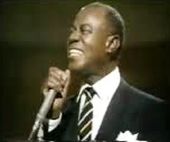
Louis Armstrong, performing.
To this day, Armstrong’s version of “What A Wonderful World” remains a popular fan favorite. Although regarded by some critics as overly sentimental, an internet query using the song’s title plus “my favorite song” on any of the search engines will usually yield postings from folks who have kind things to say about the song. Family historians crafting slide shows and video remembrances use the song in their home-made soundtracks. It’s also popular at weddings, especially for the father-daughter dance. And it is valued generally for its upbeat and optimistic outlook. In 2012, Neil McCormick, chief rock music critic at The Telegraph in London, writing about the song in a piece entitled “What Is the Happiest Song of All Time?,” had this say:
“…My vote, although it seems almost too obvious, would go to ‘What A Wonderful World,’ performed by Louis Armstrong. It’s got a beautiful rolling melody, and simple, life-affirming lyrics, but what makes it so powerful is Armstrong’s vocal, which is not smug or avuncular, his voice is so old and cracked that it contains a sense of loss within it, the bittersweet tinge of a man looking back, who has already lived a long life and is acutely aware of how precious it is. So, curiously, it seems to me there is an almost invisible shadow of melancholia in the song that actually magnifies its happiness. You can put that song on in any context, and people stop and smile.”
|
What A Wonderful World I see trees of green, red roses too I see skies of blue, and clouds of white The colors of the rainbow, so pretty in the sky I hear babies cry, I watch them grow Yes I think to myself, what a wonderful world. |
Armstrong himself stated in the late 1960s that he recalled “three generations” of children he watched growing up in his own Corona/Queens, NY neighborhood where he lived with his wife Lucille for 28 years — part of his own “life reservoir” that he brought to the song.
Add to that the “slings and arrows” suffered by a black man in America over decades during segregation and the civil rights struggle, and Armstrong’s singing of this song takes on even more depth.
Of course, every listener brings their own life experience to the song. Yet it is Armstrong’s rendition that provides the powerful starting point. And given the song’s simple yet enduring sentiments, it is likely one that will live for the ages.
Throughout his career, and after his passing, Louis Armstrong was recognized for his musical contributions. In 1972, he was posthumously awarded the Grammy Lifetime Achievement Award by the Academy of Recording Arts and Sciences – issued to performers who have made creative contributions of outstanding artistic significance to the field of recording. In 2002, his Hot Five and Hot Seven recordings from 1925–1928 were selected for the National Recording Registry at the Library of Congress.

Statue of Louis Armstrong near the Mahalia Jackson Theater in Louis Armstrong Park, New Orleans.
For additional stories on the history of music and its impact on culture, see the “Annals of Music” page, or visit the Home page for other choices. Thanks for visiting — and if you like what you find here, please make a donation to help support the research and writing at this website. Thank you. – Jack Doyle
|
Please Support Thank You |
____________________________________
Date Posted: 7 November 2012
Last Update: 26 January 2020
Comments to: jdoyle@pophistorydig.com
Article Citation:
Jack Doyle, “What A Wonderful World – Louis Armstrong:
1967-1968,” PopHistoryDig.com, November 7, 2012.
____________________________________
Sources, Links & Additional Information
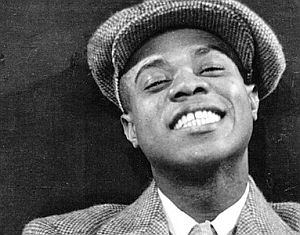 A younger Louis Armstrong in his trademark mug. |
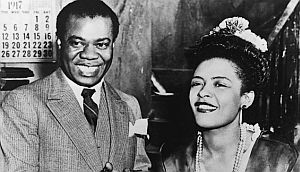 1947: Louis Armstrong and Billie Holiday. |
“Louis Armstrong’s Music Has Been Shaping History for Almost 30 Years,” New York Times, January 29, 1950.
John S. Wilson, “Home Town Hails Armstrong; 5,000 at Jazz Fete in New Orleans Cheer Trumpeter,” New York Times, Monday, May 20, 1968.
John S. Wilson, “Louis Armstrong Takes to Horn In His Comeback at the Waldorf,” New York Times, Sunday, March 7, 1971.
Albin Krebs, “Louis Armstrong, Jazz Trumpeter and Singer, Dies in His Home at 71,” New York Times, July 7, 1971, p. 1.
“Music: Last Trumpet for the First Trumpeter,” Time, Monday, July 19, 1971.
Myrna Oliver, “Bob Thiele; Record Label Owner, Producer of Top Jazz Musicians,” Los Angeles Times, February 2, 1996.
Doug Ramsey, Liner Notes, The Definitive Louis Armstrong (CD Booklet), May 2000.
“Hello, Dolly! (song),” Wikipedia.org.
Cecil Van Houten, “What A Wonderful World,” Family Life, September 22, 2011.
“What A Wonderful World,” ArtieButler. com.
“What a Wonderful World,” Wikipedia.org.
“Smashed Hits: How Political is What A Wonderful World?, BBC News Magazine, December 10, 2011.
Neil McCormick, “What Is the Happiest Song of All Time?, The Telegraph, February 1, 2012.
“Louis Armstrong,” Wikiquote.org.
“David Attenborough-Wonderful World – BBC,” YouTube.com.
“What a Wonderful World – Louis Arm- strong,” YouTube.com, sanny6667, Dec. 23, 2010.
John Burnett, “West End Blues,” National Public Radio, NPR.org, August 6, 2000.
“Louis Armstrong, Artist Page,” National Public Radio, NPR.org.
“Louis Armstrong: Biography- Jazz: A Film By Ken Burns,” PBS.org.
“Louis Armstrong,” Wikipedia.org.
William Ruhlmann, “Louis Armstrong, Biog- raphy,” AllMusic.com.
Terry Teachout, Pops: A Life of Louis Armstrong (hardcover), Boston/New York: Houghton Mifflin Harcourt, 2009, 496pp.
K. Smith, “What a Wonderful World: The Drummer’s Difference,” BroadStreetReview. com, September 25, 2011.
Cornell Thomas, “What a Wonderful World…,” PowerofPositivity.net, January 14, 2012.
“Louis Armstrong: What A Wonderful World/Cabaret,” ChartArchive.org.
Carla A. Fellers, “What a Wonderful World: The Rhetoric of the Official and Unoffical in Good Morning Vietnam,”War, Literature & The Arts, pp.232-242.
_____________________________
